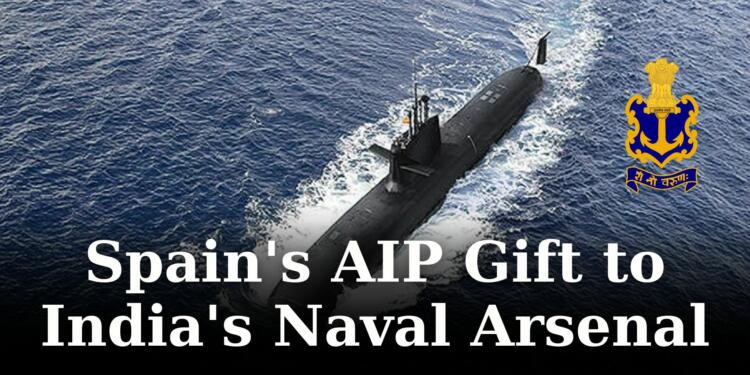Spain’s offer to transfer Air-Independent Propulsion (AIP) technology to India for its stealth submarines marks a significant milestone in defence cooperation. This deal holds paramount importance in India’s defence modernization efforts, enhancing its naval capabilities and fostering strategic partnerships. By leveraging Spain’s advanced submarine technology, India aims to bolster its maritime defence posture and strengthen bilateral ties, underscoring the critical role of international collaboration in addressing evolving security challenges.
What is Project 75?
Project-75 India (P-75 I) stands as one of India’s most pivotal defence acquisition initiatives, poised to significantly enhance the country’s naval capabilities. Envisioned as a cornerstone of India’s maritime defence strategy, P-75 I aims to procure six state-of-the-art stealth submarines equipped with cutting-edge technology. These submarines are intended to replace aging diesel-electric powered submarines that were inducted into the Indian Navy during the 1990s, thereby ensuring a modern and formidable naval fleet.
Among the contenders vying for this prestigious contract are two prominent players: Spain’s Navantia and Germany’s Thyssenkrupp. Both companies bring to the table extensive experience in submarine manufacturing and advanced defence technologies, making the competition for the P-75 I contract fiercely competitive.
Navantia, in particular, has bolstered its bid through strategic partnerships, notably with Larsen and Toubro (L&T), as part of India’s ambitious Make in India program. This collaboration underscores Navantia’s commitment to not only delivering cutting-edge submarines to the Indian Navy but also fostering indigenous defence manufacturing capabilities. By teaming up with L&T, Navantia aims to leverage India’s skilled workforce and robust industrial infrastructure to ensure the successful execution of the P-75 I project, aligning with India’s broader goal of self-reliance in defence production. This partnership also signifies a deepening of bilateral ties between Spain and India, with potential long-term implications for defence cooperation and technology transfer.
Also Read: From South to North: India’s Journey as a Global Leader
Spain’s Proposal
Spain’s proposal for the Project-75 India (P-75 I) submarine deal is characterized by a compelling combination of cutting-edge technology transfer and competitive pricing, positioning it as a formidable contender in the procurement process.
Spain has expressed its readiness to transfer complete Air-Independent Propulsion (AIP) technology to India. AIP technology is a crucial component in modern submarines, allowing them to operate underwater for extended durations without the need to surface frequently. By offering to transfer this advanced technology, Spain demonstrates its commitment to enhancing India’s naval capabilities and fostering indigenous submarine manufacturing expertise.
Furthermore, Spain’s submarines come with a competitive price tag, offering a compelling value proposition compared to other contenders like Germany’s Thyssenkrupp. Despite featuring the latest AIP technology, Spain’s submarines are touted to be more cost-effective, making them an attractive option for the Indian Navy’s procurement needs. This cost-effectiveness is likely to appeal to Indian defence planners, who seek to maximize the value of defence expenditures while acquiring cutting-edge equipment.
Highlighting the significance of Spain’s commitment to the deal, Secretary of State for Defence Amparo Valcarce is scheduled to visit India to engage in discussions with Indian counterparts. Valcarce’s visit underscores Spain’s proactive approach in advancing negotiations and underscores the importance attached to securing the P-75 I contract.
Technical Details and Benefits
Navantia’s S-80-class submarines represent a pinnacle of naval engineering, designed to meet the evolving operational requirements of modern navies. These submarines boast advanced features and capabilities, making them formidable assets in maritime defence strategies.
The S-80-class submarines are characterized by their robust construction and innovative design, featuring a displacement of approximately 3,000 tonnes. This sizable displacement allows for enhanced endurance and operational flexibility, enabling extended missions and deployments.
AIP System
Central to the S-80-class submarines is their Air-Independent Propulsion (AIP) system, a cutting-edge technology that significantly enhances underwater endurance. By utilizing AIP technology, these submarines can operate submerged for prolonged periods, reducing the need for frequent resurfacing and enhancing stealth capabilities.
Benefits of AIP Technology
AIP technology offers several advantages, including reduced acoustic signature, increased operational range, and improved survivability. By minimizing reliance on traditional diesel-electric propulsion systems, AIP-equipped submarines can conduct covert operations with enhanced stealth, making them well-suited for reconnaissance, surveillance, and intelligence gathering missions.
Export Potential
Navantia’s plans to export submarines manufactured in India to other countries represent a significant opportunity for India’s defence manufacturing capabilities. By leveraging India’s skilled workforce and industrial infrastructure, Navantia aims to establish India as a hub for submarine production, catering to global demand and bolstering the country’s defence manufacturing ecosystem.
Also Read: From Jungle to Jetset: Great Nicobar’s Rise Amidst China’s Oceanic Ambitions
Past Collaborations and Future Prospects
Navantia’s history of collaboration in India, particularly in the transfer of technology for Scorpene submarines, underscores the depth of bilateral defence ties between India and Spain. This collaboration has not only enhanced India’s naval capabilities but also laid the groundwork for future cooperation in defence manufacturing and technology transfer.
Strategic Implications
The submarine deal holds long-term strategic implications for both India and Spain. For India, the acquisition of advanced submarines strengthens its maritime defence posture and enhances its ability to safeguard its maritime interests. For Spain, successful collaboration in defence procurement opens avenues for broader strategic engagement with India, potentially extending to areas such as counterterrorism, cybersecurity, and maritime security cooperation.
Future defence Cooperation
The submarine deal sets a precedent for future defence cooperation between India and Spain, paving the way for expanded collaboration in areas such as joint research and development, technology transfer, and defence industrial partnerships. Potential areas for cooperation include surface ships, naval aviation, and maritime surveillance systems, offering mutual benefits and bolstering bilateral defence ties.
Also Read: Sailing Through History: The Epic Journey of India’s Naval Titans































